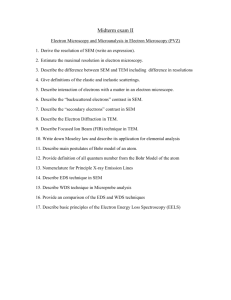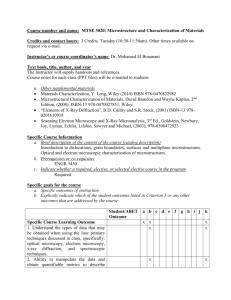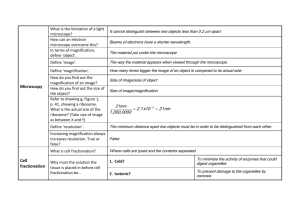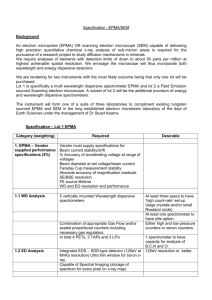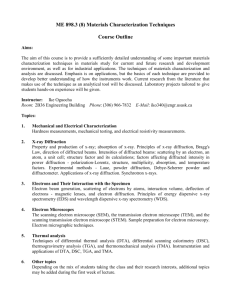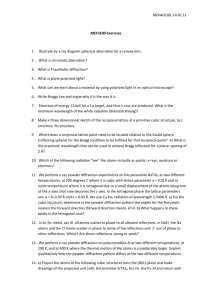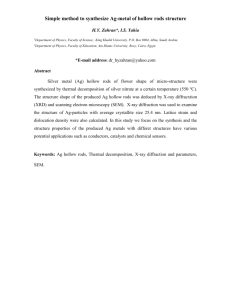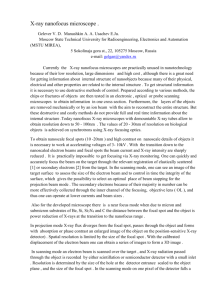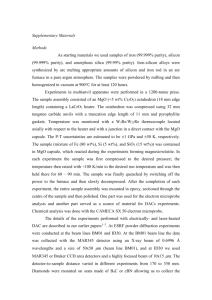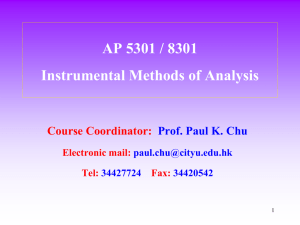Review Problems on Optical Microscopy
advertisement
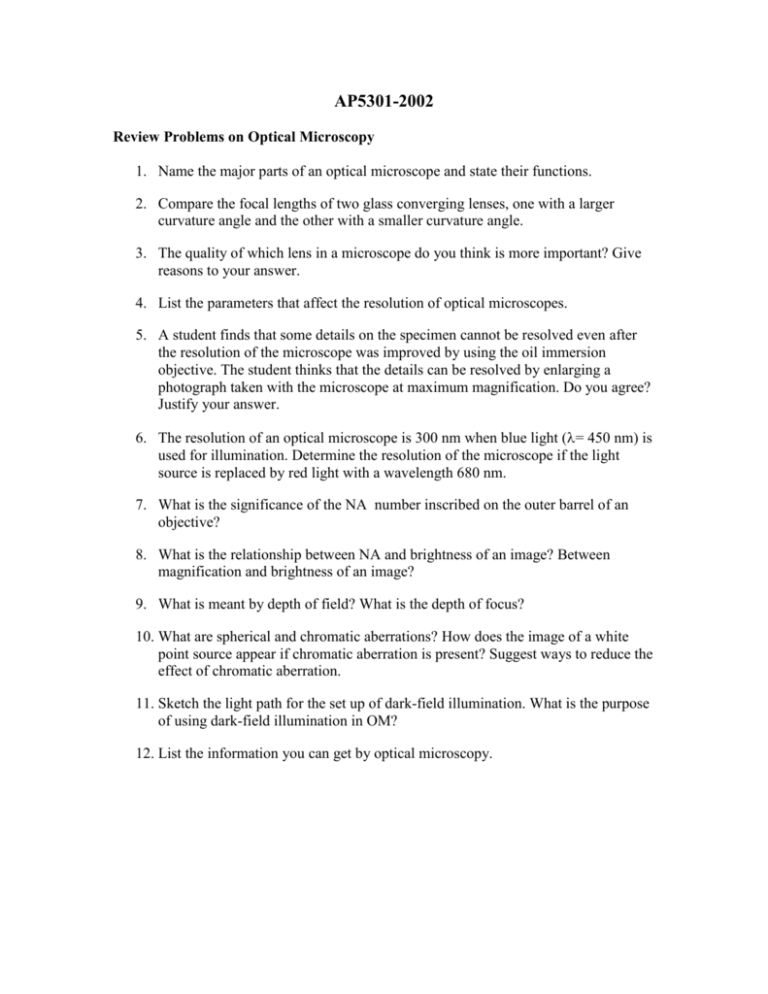
AP5301-2002 Review Problems on Optical Microscopy 1. Name the major parts of an optical microscope and state their functions. 2. Compare the focal lengths of two glass converging lenses, one with a larger curvature angle and the other with a smaller curvature angle. 3. The quality of which lens in a microscope do you think is more important? Give reasons to your answer. 4. List the parameters that affect the resolution of optical microscopes. 5. A student finds that some details on the specimen cannot be resolved even after the resolution of the microscope was improved by using the oil immersion objective. The student thinks that the details can be resolved by enlarging a photograph taken with the microscope at maximum magnification. Do you agree? Justify your answer. 6. The resolution of an optical microscope is 300 nm when blue light (= 450 nm) is used for illumination. Determine the resolution of the microscope if the light source is replaced by red light with a wavelength 680 nm. 7. What is the significance of the NA number inscribed on the outer barrel of an objective? 8. What is the relationship between NA and brightness of an image? Between magnification and brightness of an image? 9. What is meant by depth of field? What is the depth of focus? 10. What are spherical and chromatic aberrations? How does the image of a white point source appear if chromatic aberration is present? Suggest ways to reduce the effect of chromatic aberration. 11. Sketch the light path for the set up of dark-field illumination. What is the purpose of using dark-field illumination in OM? 12. List the information you can get by optical microscopy. Review Problems on Scanning Electron Microscopy 1. A SEM image at 10,000 magnification is displayed on a screen 10cm10cm. What is the actual area scanned on the specimen? 2. If the screen used in the SEM in Question 1 has resolution 10001000 pixels. Calculate the pixel size on the specimen. 3. Distinguish between interaction volume and escape volume. 4. Compare the origins and characteristics of backscattered electrons and secondary electrons. 5. Sketch the shape of the escape volume for the major signals from the specimen and give rough value of the diameter of the escape volumes if the incident electron beam has a diameter of 5 nm. 6. Sketch schematically the construction of a thermionic electron gun and state the functions of the major components. 7. Explain how magnetic lenses can focus an electron beam. 8. Give reasons why the SEM column and the specimen chamber must be kept at good vacuum. 9. What are the origins of the image contrast in a SEM image? 10. Explain the criteria for determining the optimum electron beam size for imaging. 11. Suggest ways to increase the depth of field for the images in a SEM. 12. Compare the merits and drawbacks of EDX and WDS. Review Problems on Scanning Probe Microscopy 1. List factors influencing the resolution of SPM 2. Assuming that at low voltages and temperature the tunneling current is given by I exp(-0.2d) where d is tip-sample spacing (Å). If the current is kept constant to within 2%, i.e., I/I=0.02, show the current sensitivity to tip-sample spacing, i.e., what is d? 3. What kind of working mode in AFM should be used to distinguish the topography from electrostatic or magnetic forces? 4. Describe imaging mechanisms of SEM and SPM. 5. Compare SEM and AFM techniques with respect to 4 factors: (1) Surface structure, (2) Composition, (3) Working environment, and (4) Specimen requirement. Review Problems on X-ray Diffraction 1. What is the frequency (per second) and energy per quantum (in joules) of x-ray beams of wavelength 0.71Å (Mo K) and 1.54 Å (Cu K)? 2. Calculate the velocity and kinetic energy with which the electrons strike the target of an x-ray tube operated at 50,000 volts. 3. What is short wavelength limit (SWL) in the spectrum of the x-rays generated by an x-ray tube? Calculate the SWL for the acceleration voltage of 30kV. 4. Assume that air contains 80 percent nitrogen and 20 percent oxygen by weight and has a density of 1.29x10-3g/cm3. The mass absorption coefficients of N and O for Cr K radiation are 24.42 and 37.19 cm2/gm, respectively. Calculate the transmission factor, I./Io, of air for Cr K radiation and a path length of 20cm, where Io-intensity of incident x-ray beam and I-intensity of transmitted beam after passing through a thickness x. The mass absorption coefficients of air for Cr K radiation is given by (/)air = wN(/)N + wO(/)O where wN and wO are the weight fractions of N and O in air, respectively. 5. Draw the following planes and directions in a FCC unit cell: (200), ( 1 01), (112), [1 1 0], [ 1 1 1 ]. 6. Determine, and list in order of increasing angle, the values of 2 and (hkl) for the first four lines (those of lowest 2 values) on the powder XRD patterns of substances with the following two structures, the incident radiation being Cu K with a =1.5418 Å: (a) simple cubic with a=4.0 Å and (b) simple tetragonal with a=3.99 Å and c=4.03 Å 7. List information provided by measuring the peak position, peak width (FWHM) and peak intensity of a XRD pattern. 8. Calculate the structure factor, Fhkl, for a base-centered unit cell as shown below, which has two atoms of the same kind and located at 000 and ½½0. Review Problems on Transmission Electron Microscopy 1. Derive Bragg’s Law in terms of real and reciprocal spaces. 2. Diffraction occurs when an electron beam hits an [001] oriented thin cubic crystal sample (a=4.16Å). Estimate the number of diffraction spots (in one dimension) generated by a beam with an accelerating voltage of 80kV. What is the number of diffraction spots if the wavelength is 40 times larger (about the range of X-ray wavelength)? Using website at http://www.matter.org.uk/diffraction/geometry/ewald_sphere_diffraction_patterns.htm to do estimation. 3. What factors limit the theoretical resolution of a TEM? What is the practical resolution (rmin) of a TEM with a coefficient of spherical aberration of lens = 3mm and an accelerating voltage, U, of 100keV. What is rmin if U = 200keV or 300keV? 4. What does a reciprocal lattice point or a diffraction spot in a SAED pattern stand for? 5. [100] SAED pattern of a simple tetragonal sample is shown below, which was obtained using an electron beam of 100keV and camera length of 800mm. The distances between the center transmitted beam and (010) and (001) diffracted beams are 7.5 and 7.4mm, respectively. Calculate the c/a ratio of the simple tetragonal unit cell and d101 and d110. 6. In real space (Fig.A) sketch (1 1 1), (123) and ( 1 10) planes and in reciprocal space (Fig.B) label the remaining six reciprocal lattice points. Calculate the angle between the (111) and (110) in a cubic unit cell. The angle between two planes in a cubic cell is given at http://www.matter.org.uk/diffraction/electron/calculating_angle_between_2_planes.htm 7. Sketch SAED patterns of single crystal, polycrystalline and amorphous TEM specimens. 8. List names of magnetic lenses and their functions of a TEM. What is one big advantage to using electro-magnets and electrons over glass lenses and light?
